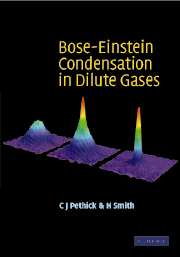Book contents
- Frontmatter
- Contents
- Preface
- 1 Introduction
- 2 The non-interacting Bose gas
- 3 Atomic properties
- 4 Trapping and cooling of atoms
- 5 Interactions between atoms
- 6 Theory of the condensed state
- 7 Dynamics of the condensate
- 8 Microscopic theory of the Bose gas
- 9 Rotating condensates
- 10 Superfluidity
- 11 Trapped clouds at non-zero temperature
- 12 Mixtures and spinor condensates
- 13 Interference and correlations
- 14 Fermions
- Appendix. Fundamental constants and conversion factors
- Index
6 - Theory of the condensed state
Published online by Cambridge University Press: 06 July 2010
- Frontmatter
- Contents
- Preface
- 1 Introduction
- 2 The non-interacting Bose gas
- 3 Atomic properties
- 4 Trapping and cooling of atoms
- 5 Interactions between atoms
- 6 Theory of the condensed state
- 7 Dynamics of the condensate
- 8 Microscopic theory of the Bose gas
- 9 Rotating condensates
- 10 Superfluidity
- 11 Trapped clouds at non-zero temperature
- 12 Mixtures and spinor condensates
- 13 Interference and correlations
- 14 Fermions
- Appendix. Fundamental constants and conversion factors
- Index
Summary
In the present chapter we consider the structure of the Bose–Einstein condensed state in the presence of interactions. Our discussion is based on the Gross–Pitaevskii equation, which describes the zero-temperature properties of the non-uniform Bose gas when the scattering length a is much less than the mean interparticle spacing. We shall first derive the Gross–Pitaevskii equation at zero temperature by treating the interaction between particles in a mean-field approximation (Sec. 6.1). Following that, in Sec. 6.2 we discuss the ground state of atomic clouds in a harmonic-oscillator potential. We compare results obtained by variational methods with those derived in the Thomas-Fermi approximation, in which the kinetic energy operator is neglected in the Gross–Pitaevskii equation. The Thomas–Fermi approximation fails near the surface of a cloud, and in Sec. 6.3 we calculate the surface structure using the Gross–Pitaevskii equation. Finally, in Sec. 6.4 we determine how the condensate wave function ‘heals’ when subjected to a localized disturbance.
The Gross–Pitaevskii equation
In the previous chapter we have shown that the effective interaction between two particles at low energies is a constant in the momentum representation, U0 = 4πħ2a/m. In coordinate space this corresponds to a contact interaction U0δ(r – r′), where r and r′ are the positions of the two particles. To investigate the energy of man y-body states we adopt a Hartree or mean-field approach, and assume that the wave function is a symmetrized product of single-particle wave functions.
- Type
- Chapter
- Information
- Bose–Einstein Condensation in Dilute Gases , pp. 146 - 164Publisher: Cambridge University PressPrint publication year: 2001



